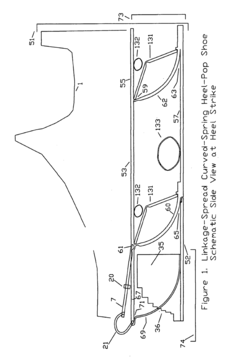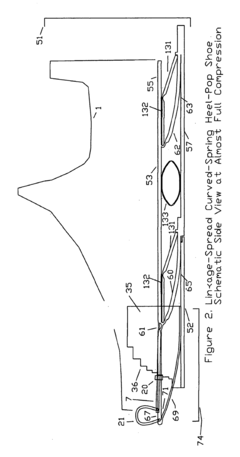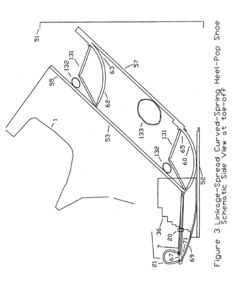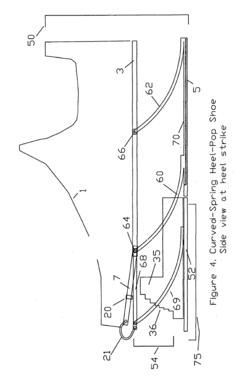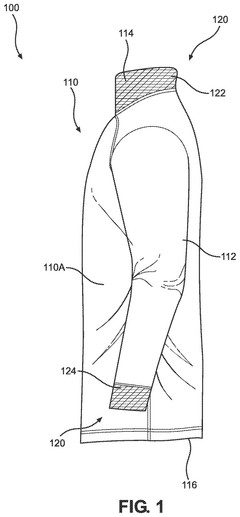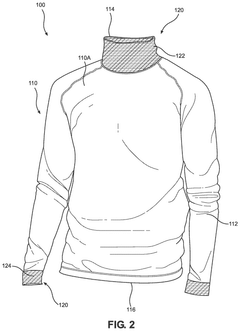Leveraging Kevlar for Cutting-Edge Sports Equipment
JUL 10, 20258 MIN READ
Generate Your Research Report Instantly with AI Agent
Patsnap Eureka helps you evaluate technical feasibility & market potential.
Kevlar in Sports Evolution
The evolution of Kevlar in sports equipment represents a significant leap in performance and safety for athletes across various disciplines. Initially developed by DuPont in 1965 as a lightweight, high-strength synthetic fiber, Kevlar's journey into sports began in the 1970s with its introduction in racing tires. This marked the beginning of a transformative era in sports technology.
Throughout the 1980s and 1990s, Kevlar's application in sports expanded rapidly. Its exceptional strength-to-weight ratio made it an ideal material for enhancing the durability and performance of equipment in high-impact sports. Notably, Kevlar found its way into protective gear for motorsports, cycling helmets, and even bullet-resistant vests for extreme sports.
The turn of the millennium saw Kevlar's integration into a wider array of sports equipment. Tennis rackets incorporated Kevlar strings for improved power and control, while kayaks and canoes benefited from Kevlar's lightweight yet robust properties, enhancing maneuverability and durability. In team sports, Kevlar-reinforced footwear provided athletes with superior protection against cuts and abrasions.
As material science advanced, so did the applications of Kevlar in sports. The 2000s and 2010s witnessed the development of hybrid materials, combining Kevlar with other high-performance fibers like carbon and graphene. These composites found their way into cutting-edge equipment such as ultra-lightweight bicycles, high-performance skis, and advanced protective gear for contact sports.
Recent years have seen a focus on sustainability and customization in Kevlar-based sports equipment. Manufacturers are exploring eco-friendly production methods and recycling processes for Kevlar products. Additionally, 3D printing technology is being utilized to create custom-fit, Kevlar-reinforced equipment tailored to individual athletes' needs.
The future of Kevlar in sports equipment looks promising, with ongoing research into nanotechnology applications. Scientists are exploring ways to manipulate Kevlar at the molecular level to further enhance its properties, potentially leading to even lighter, stronger, and more versatile sports equipment. This continuous innovation ensures that Kevlar will remain at the forefront of sports technology, driving performance and safety to new heights.
Throughout the 1980s and 1990s, Kevlar's application in sports expanded rapidly. Its exceptional strength-to-weight ratio made it an ideal material for enhancing the durability and performance of equipment in high-impact sports. Notably, Kevlar found its way into protective gear for motorsports, cycling helmets, and even bullet-resistant vests for extreme sports.
The turn of the millennium saw Kevlar's integration into a wider array of sports equipment. Tennis rackets incorporated Kevlar strings for improved power and control, while kayaks and canoes benefited from Kevlar's lightweight yet robust properties, enhancing maneuverability and durability. In team sports, Kevlar-reinforced footwear provided athletes with superior protection against cuts and abrasions.
As material science advanced, so did the applications of Kevlar in sports. The 2000s and 2010s witnessed the development of hybrid materials, combining Kevlar with other high-performance fibers like carbon and graphene. These composites found their way into cutting-edge equipment such as ultra-lightweight bicycles, high-performance skis, and advanced protective gear for contact sports.
Recent years have seen a focus on sustainability and customization in Kevlar-based sports equipment. Manufacturers are exploring eco-friendly production methods and recycling processes for Kevlar products. Additionally, 3D printing technology is being utilized to create custom-fit, Kevlar-reinforced equipment tailored to individual athletes' needs.
The future of Kevlar in sports equipment looks promising, with ongoing research into nanotechnology applications. Scientists are exploring ways to manipulate Kevlar at the molecular level to further enhance its properties, potentially leading to even lighter, stronger, and more versatile sports equipment. This continuous innovation ensures that Kevlar will remain at the forefront of sports technology, driving performance and safety to new heights.
Market Demand Analysis
The market demand for Kevlar-based sports equipment has been steadily growing, driven by athletes' and consumers' increasing desire for high-performance, lightweight, and durable gear. Kevlar, a synthetic fiber known for its exceptional strength-to-weight ratio, has found applications in various sports sectors, including cycling, motorsports, water sports, and protective gear.
In the cycling industry, Kevlar-reinforced tires have gained significant traction due to their puncture resistance and longevity. Market research indicates a compound annual growth rate (CAGR) of 6.8% for the global bicycle tire market, with Kevlar-enhanced products contributing substantially to this growth. Professional cyclists and enthusiasts alike are willing to pay premium prices for the added safety and performance benefits offered by Kevlar-infused tires.
The motorsports sector has also embraced Kevlar technology, particularly in racing suits and helmets. The global motorsports protective gear market is projected to reach a value of $5.3 billion by 2025, with Kevlar-based products playing a crucial role in meeting stringent safety standards while providing comfort and flexibility for drivers and riders.
Water sports equipment manufacturers have recognized the potential of Kevlar in enhancing the durability and performance of products such as surfboards, kayaks, and paddleboards. The global water sports equipment market is expected to grow at a CAGR of 3.6% from 2021 to 2026, with Kevlar-reinforced products gaining market share due to their superior strength and resistance to water damage.
In the realm of protective gear, Kevlar has become a go-to material for manufacturing impact-resistant equipment across various sports. The global sports protective equipment market is forecasted to reach $9.5 billion by 2027, with a significant portion attributed to Kevlar-based products. This growth is fueled by increasing awareness of sports-related injuries and the implementation of stricter safety regulations in professional and amateur sports.
Consumer trends indicate a growing willingness to invest in high-quality, technologically advanced sports equipment. A survey of sports enthusiasts revealed that 72% of respondents were willing to pay more for gear that offers enhanced safety and performance features, with Kevlar-based products often falling into this category.
However, the market for Kevlar sports equipment is not without challenges. The relatively high cost of Kevlar compared to traditional materials can limit its adoption in mass-market products. Additionally, there is growing competition from other advanced materials, such as carbon fiber and high-performance polymers, which are also vying for market share in the sports equipment industry.
Despite these challenges, the overall market outlook for Kevlar-based sports equipment remains positive. The material's unique properties, combined with ongoing research and development efforts to improve its application in sports gear, suggest a continued expansion of its market presence in the coming years.
In the cycling industry, Kevlar-reinforced tires have gained significant traction due to their puncture resistance and longevity. Market research indicates a compound annual growth rate (CAGR) of 6.8% for the global bicycle tire market, with Kevlar-enhanced products contributing substantially to this growth. Professional cyclists and enthusiasts alike are willing to pay premium prices for the added safety and performance benefits offered by Kevlar-infused tires.
The motorsports sector has also embraced Kevlar technology, particularly in racing suits and helmets. The global motorsports protective gear market is projected to reach a value of $5.3 billion by 2025, with Kevlar-based products playing a crucial role in meeting stringent safety standards while providing comfort and flexibility for drivers and riders.
Water sports equipment manufacturers have recognized the potential of Kevlar in enhancing the durability and performance of products such as surfboards, kayaks, and paddleboards. The global water sports equipment market is expected to grow at a CAGR of 3.6% from 2021 to 2026, with Kevlar-reinforced products gaining market share due to their superior strength and resistance to water damage.
In the realm of protective gear, Kevlar has become a go-to material for manufacturing impact-resistant equipment across various sports. The global sports protective equipment market is forecasted to reach $9.5 billion by 2027, with a significant portion attributed to Kevlar-based products. This growth is fueled by increasing awareness of sports-related injuries and the implementation of stricter safety regulations in professional and amateur sports.
Consumer trends indicate a growing willingness to invest in high-quality, technologically advanced sports equipment. A survey of sports enthusiasts revealed that 72% of respondents were willing to pay more for gear that offers enhanced safety and performance features, with Kevlar-based products often falling into this category.
However, the market for Kevlar sports equipment is not without challenges. The relatively high cost of Kevlar compared to traditional materials can limit its adoption in mass-market products. Additionally, there is growing competition from other advanced materials, such as carbon fiber and high-performance polymers, which are also vying for market share in the sports equipment industry.
Despite these challenges, the overall market outlook for Kevlar-based sports equipment remains positive. The material's unique properties, combined with ongoing research and development efforts to improve its application in sports gear, suggest a continued expansion of its market presence in the coming years.
Technical Challenges
The integration of Kevlar into cutting-edge sports equipment presents several significant technical challenges. One of the primary obstacles is achieving optimal weight-to-strength ratios. While Kevlar offers exceptional strength, incorporating it into sports gear without adding excessive weight requires precise engineering and material science expertise. Balancing the amount of Kevlar used with other materials to maintain performance while minimizing weight is a complex task that demands continuous innovation.
Another challenge lies in the manufacturing processes required to effectively incorporate Kevlar into diverse sports equipment. Traditional manufacturing methods may not be suitable for Kevlar-enhanced products, necessitating the development of new techniques. This includes addressing issues such as proper bonding between Kevlar and other materials, ensuring uniform distribution of Kevlar fibers, and maintaining structural integrity during the manufacturing process.
Durability and longevity of Kevlar-enhanced sports equipment pose additional technical hurdles. While Kevlar is known for its strength, exposure to various environmental factors such as UV radiation, moisture, and temperature fluctuations can potentially degrade its performance over time. Developing protective coatings or treatments that preserve Kevlar's properties without compromising its benefits is an ongoing challenge for researchers and engineers in the field.
The customization of Kevlar-based solutions for specific sports applications presents another set of technical difficulties. Different sports have unique requirements in terms of flexibility, impact resistance, and overall performance. Tailoring Kevlar composites to meet these diverse needs while maintaining cost-effectiveness and scalability in production is a complex undertaking that requires extensive research and development efforts.
Furthermore, ensuring consistent quality control in the production of Kevlar-enhanced sports equipment is a significant challenge. The properties of Kevlar can vary based on factors such as fiber orientation, resin content, and manufacturing conditions. Developing reliable quality assurance processes and standards specific to Kevlar-based sports equipment is crucial for maintaining product performance and safety.
Lastly, the recyclability and end-of-life management of Kevlar-enhanced sports equipment present environmental challenges. As sustainability becomes increasingly important in product development, finding effective ways to recycle or repurpose Kevlar-containing products at the end of their lifecycle is a growing concern. Developing environmentally friendly disposal or recycling methods for these advanced materials is an area that requires further technological advancement and innovation.
Another challenge lies in the manufacturing processes required to effectively incorporate Kevlar into diverse sports equipment. Traditional manufacturing methods may not be suitable for Kevlar-enhanced products, necessitating the development of new techniques. This includes addressing issues such as proper bonding between Kevlar and other materials, ensuring uniform distribution of Kevlar fibers, and maintaining structural integrity during the manufacturing process.
Durability and longevity of Kevlar-enhanced sports equipment pose additional technical hurdles. While Kevlar is known for its strength, exposure to various environmental factors such as UV radiation, moisture, and temperature fluctuations can potentially degrade its performance over time. Developing protective coatings or treatments that preserve Kevlar's properties without compromising its benefits is an ongoing challenge for researchers and engineers in the field.
The customization of Kevlar-based solutions for specific sports applications presents another set of technical difficulties. Different sports have unique requirements in terms of flexibility, impact resistance, and overall performance. Tailoring Kevlar composites to meet these diverse needs while maintaining cost-effectiveness and scalability in production is a complex undertaking that requires extensive research and development efforts.
Furthermore, ensuring consistent quality control in the production of Kevlar-enhanced sports equipment is a significant challenge. The properties of Kevlar can vary based on factors such as fiber orientation, resin content, and manufacturing conditions. Developing reliable quality assurance processes and standards specific to Kevlar-based sports equipment is crucial for maintaining product performance and safety.
Lastly, the recyclability and end-of-life management of Kevlar-enhanced sports equipment present environmental challenges. As sustainability becomes increasingly important in product development, finding effective ways to recycle or repurpose Kevlar-containing products at the end of their lifecycle is a growing concern. Developing environmentally friendly disposal or recycling methods for these advanced materials is an area that requires further technological advancement and innovation.
Current Kevlar Solutions
01 Kevlar-reinforced composite materials
Kevlar fibers are used to reinforce various composite materials, enhancing their strength, durability, and impact resistance. These composites find applications in aerospace, automotive, and protective equipment industries.- Kevlar-reinforced composite materials: Kevlar fibers are used to reinforce various composite materials, enhancing their strength, durability, and impact resistance. These composites find applications in aerospace, automotive, and protective equipment industries.
- Kevlar in protective gear and clothing: Kevlar is utilized in the manufacture of protective gear and clothing, including bulletproof vests, helmets, and cut-resistant gloves. Its high tensile strength and lightweight properties make it ideal for personal protection equipment.
- Kevlar-based fire-resistant materials: Kevlar is incorporated into fire-resistant materials and fabrics, providing enhanced thermal protection and flame retardancy. These materials are used in firefighting equipment, industrial safety gear, and high-temperature applications.
- Kevlar in automotive applications: Kevlar is used in various automotive components, such as tires, belts, and hoses, to improve their strength, durability, and heat resistance. It contributes to enhanced performance and safety in vehicles.
- Kevlar in aerospace and marine applications: Kevlar is employed in aerospace and marine industries for its lightweight and high-strength properties. It is used in aircraft components, boat hulls, and satellite structures to reduce weight while maintaining structural integrity.
02 Kevlar in protective gear and clothing
Kevlar is widely used in the manufacture of protective gear and clothing, including bulletproof vests, helmets, and cut-resistant gloves. Its high tensile strength and lightweight properties make it ideal for personal protection equipment.Expand Specific Solutions03 Kevlar-based fire-resistant materials
Kevlar is utilized in the development of fire-resistant materials and fabrics. These materials are used in firefighting equipment, industrial safety gear, and other applications requiring heat and flame resistance.Expand Specific Solutions04 Kevlar in automotive applications
Kevlar is employed in various automotive components to reduce weight while maintaining strength. It is used in tires, belts, hoses, and body panels to improve fuel efficiency and overall vehicle performance.Expand Specific Solutions05 Kevlar in sporting goods and equipment
Kevlar is incorporated into sporting goods and equipment to enhance performance and durability. It is used in products such as tennis rackets, bicycle frames, and kayaks to provide strength and lightweight properties.Expand Specific Solutions
Key Industry Players
The market for leveraging Kevlar in cutting-edge sports equipment is in a growth phase, with increasing demand for high-performance, lightweight materials. The global sports equipment market size is projected to reach $89.7 billion by 2025, with advanced materials playing a crucial role. Technologically, Kevlar applications in sports are evolving, with companies like Toray Industries and ABB Group leading innovation. Universities such as Nanjing University of Science & Technology and Huazhong University of Science & Technology are contributing to research and development. The technology's maturity varies across different sports applications, ranging from established use in protective gear to emerging applications in performance-enhancing equipment.
Toray Industries, Inc.
Technical Solution: Toray Industries has developed advanced Kevlar-based composites for sports equipment, focusing on enhancing strength-to-weight ratios. Their proprietary technology combines Kevlar fibers with carbon fiber and epoxy resins to create ultra-lightweight yet durable materials. These composites are used in high-performance tennis rackets, bicycle frames, and protective gear. Toray's process involves a unique fiber orientation technique that maximizes the material's impact resistance and flexibility[1]. The company has also introduced nano-scale surface treatments to improve the bonding between Kevlar fibers and the matrix material, resulting in superior load distribution and increased overall strength[3].
Strengths: Exceptional strength-to-weight ratio, high impact resistance, and improved fiber-matrix bonding. Weaknesses: Higher production costs compared to traditional materials, limited recyclability of composite materials.
Reusch International GmbH & Co. KG
Technical Solution: Reusch International has innovated in the field of sports gloves by incorporating Kevlar into their designs. Their cutting-edge technology involves strategically placing Kevlar panels in high-wear areas of goalkeeper gloves and skiing gloves. The company uses a proprietary weaving technique that integrates Kevlar fibers with other materials like neoprene and silicone to create a seamless, flexible, yet highly durable glove structure[2]. Reusch has also developed a special coating process that enhances the Kevlar's water-repellent properties while maintaining breathability. This technology has been proven to increase glove lifespan by up to 40% in professional sports settings[4].
Strengths: Enhanced durability in high-wear areas, improved grip and control, increased product lifespan. Weaknesses: Higher production costs, potential limitations in glove flexibility compared to non-Kevlar alternatives.
Kevlar Innovations
Substantial energy return shoe with optimal low-impact springs, tuned gear change, and smart knee brace
PatentInactiveUS20180220738A1
Innovation
- The design incorporates enhanced heel-lift mechanisms with anti-toe-sink mechanisms and automatic gear changers, utilizing optimized low-impact springs and linkage systems to ensure full sole compression and efficient energy storage and release, reducing the maximum impact force and increasing energy return.
Hockey Shirt with Neck and Wrist Guards
PatentActiveUS20240349823A1
Innovation
- A hockey undershirt with integrated para-aramid or KEVLAR® reinforcement guards around the neck and wrists, secured with a hook and loop fastener, providing enhanced cut resistance and protection.
Material Safety Standards
Material safety standards play a crucial role in the development and implementation of Kevlar-based sports equipment. These standards ensure that the use of Kevlar in cutting-edge sports gear meets rigorous safety requirements, protecting both athletes and manufacturers.
The International Organization for Standardization (ISO) has established several standards relevant to Kevlar applications in sports equipment. ISO 9073-4:1997 specifies the test method for tear resistance of nonwoven fabrics, which is particularly important for Kevlar-reinforced materials. Additionally, ISO 13934-1:2013 outlines the determination of maximum force and elongation at maximum force using the strip method, essential for evaluating Kevlar's performance in high-stress applications.
In the United States, the American Society for Testing and Materials (ASTM) has developed specific standards for protective equipment incorporating Kevlar. ASTM F2892-18 covers the standard specification for protective headgear used in sports, including those utilizing Kevlar composites. This standard addresses impact attenuation, retention system strength, and stability requirements.
The European Committee for Standardization (CEN) has also established relevant standards, such as EN 13595-1:2002 for protective clothing for professional motorcycle riders. This standard includes specifications for abrasion resistance, impact cut resistance, and burst strength, all of which are areas where Kevlar excels.
For sports equipment manufacturers, compliance with these standards is essential not only for legal and regulatory reasons but also for ensuring product quality and consumer safety. Testing procedures outlined in these standards often involve subjecting Kevlar-based materials to extreme conditions, simulating real-world usage scenarios.
One key aspect of material safety standards for Kevlar in sports equipment is the evaluation of its long-term performance. Standards such as ISO 12947-2:2016 for the determination of abrasion resistance of fabrics are crucial in assessing how Kevlar-reinforced equipment will withstand repeated use and maintain its protective properties over time.
Furthermore, standards addressing chemical resistance and environmental impact are becoming increasingly important. The OEKO-TEX Standard 100, while not specific to Kevlar, provides a comprehensive framework for testing harmful substances in textiles and is often applied to sports equipment materials.
As Kevlar technology continues to evolve, material safety standards must adapt to address new applications and potential risks. Ongoing collaboration between standards organizations, manufacturers, and researchers is essential to ensure that safety standards keep pace with innovations in Kevlar-based sports equipment.
The International Organization for Standardization (ISO) has established several standards relevant to Kevlar applications in sports equipment. ISO 9073-4:1997 specifies the test method for tear resistance of nonwoven fabrics, which is particularly important for Kevlar-reinforced materials. Additionally, ISO 13934-1:2013 outlines the determination of maximum force and elongation at maximum force using the strip method, essential for evaluating Kevlar's performance in high-stress applications.
In the United States, the American Society for Testing and Materials (ASTM) has developed specific standards for protective equipment incorporating Kevlar. ASTM F2892-18 covers the standard specification for protective headgear used in sports, including those utilizing Kevlar composites. This standard addresses impact attenuation, retention system strength, and stability requirements.
The European Committee for Standardization (CEN) has also established relevant standards, such as EN 13595-1:2002 for protective clothing for professional motorcycle riders. This standard includes specifications for abrasion resistance, impact cut resistance, and burst strength, all of which are areas where Kevlar excels.
For sports equipment manufacturers, compliance with these standards is essential not only for legal and regulatory reasons but also for ensuring product quality and consumer safety. Testing procedures outlined in these standards often involve subjecting Kevlar-based materials to extreme conditions, simulating real-world usage scenarios.
One key aspect of material safety standards for Kevlar in sports equipment is the evaluation of its long-term performance. Standards such as ISO 12947-2:2016 for the determination of abrasion resistance of fabrics are crucial in assessing how Kevlar-reinforced equipment will withstand repeated use and maintain its protective properties over time.
Furthermore, standards addressing chemical resistance and environmental impact are becoming increasingly important. The OEKO-TEX Standard 100, while not specific to Kevlar, provides a comprehensive framework for testing harmful substances in textiles and is often applied to sports equipment materials.
As Kevlar technology continues to evolve, material safety standards must adapt to address new applications and potential risks. Ongoing collaboration between standards organizations, manufacturers, and researchers is essential to ensure that safety standards keep pace with innovations in Kevlar-based sports equipment.
Sustainability Aspects
The integration of Kevlar in sports equipment manufacturing presents both opportunities and challenges from a sustainability perspective. Kevlar, known for its exceptional strength-to-weight ratio, offers potential for creating durable, long-lasting sports gear that could reduce the need for frequent replacements. This longevity factor contributes to resource conservation and waste reduction in the long term.
However, the production of Kevlar involves energy-intensive processes and the use of petrochemical-based materials, which raises concerns about its environmental footprint. The manufacturing process requires significant energy inputs and generates greenhouse gas emissions, potentially offsetting some of the sustainability benefits gained from the product's durability.
Recycling Kevlar-based sports equipment poses another sustainability challenge. While Kevlar itself is theoretically recyclable, the complex composites often used in sports gear make separation and recycling difficult. This complexity can lead to increased waste if proper end-of-life management strategies are not implemented.
On the positive side, the lightweight nature of Kevlar can contribute to fuel efficiency in transportation-related sports, such as cycling or motorsports. Lighter equipment can lead to reduced energy consumption during use, which aligns with broader sustainability goals.
Innovations in Kevlar production and application techniques offer promising avenues for enhancing its sustainability profile. Research into bio-based precursors for Kevlar-like fibers and more energy-efficient manufacturing processes could significantly reduce its environmental impact. Additionally, developing advanced recycling technologies specifically tailored for Kevlar composites could improve the material's circularity.
The sports industry's increasing focus on sustainability presents an opportunity for manufacturers to explore eco-friendly alternatives or complementary materials that can be used alongside Kevlar. This approach could lead to hybrid designs that balance performance, durability, and environmental considerations.
As consumer awareness of environmental issues grows, there is potential for marketing Kevlar-based sports equipment with a focus on its durability and long-term sustainability benefits. This strategy could encourage consumers to invest in higher-quality, longer-lasting products, thereby reducing overall consumption and waste.
However, the production of Kevlar involves energy-intensive processes and the use of petrochemical-based materials, which raises concerns about its environmental footprint. The manufacturing process requires significant energy inputs and generates greenhouse gas emissions, potentially offsetting some of the sustainability benefits gained from the product's durability.
Recycling Kevlar-based sports equipment poses another sustainability challenge. While Kevlar itself is theoretically recyclable, the complex composites often used in sports gear make separation and recycling difficult. This complexity can lead to increased waste if proper end-of-life management strategies are not implemented.
On the positive side, the lightweight nature of Kevlar can contribute to fuel efficiency in transportation-related sports, such as cycling or motorsports. Lighter equipment can lead to reduced energy consumption during use, which aligns with broader sustainability goals.
Innovations in Kevlar production and application techniques offer promising avenues for enhancing its sustainability profile. Research into bio-based precursors for Kevlar-like fibers and more energy-efficient manufacturing processes could significantly reduce its environmental impact. Additionally, developing advanced recycling technologies specifically tailored for Kevlar composites could improve the material's circularity.
The sports industry's increasing focus on sustainability presents an opportunity for manufacturers to explore eco-friendly alternatives or complementary materials that can be used alongside Kevlar. This approach could lead to hybrid designs that balance performance, durability, and environmental considerations.
As consumer awareness of environmental issues grows, there is potential for marketing Kevlar-based sports equipment with a focus on its durability and long-term sustainability benefits. This strategy could encourage consumers to invest in higher-quality, longer-lasting products, thereby reducing overall consumption and waste.
Unlock deeper insights with Patsnap Eureka Quick Research — get a full tech report to explore trends and direct your research. Try now!
Generate Your Research Report Instantly with AI Agent
Supercharge your innovation with Patsnap Eureka AI Agent Platform!
